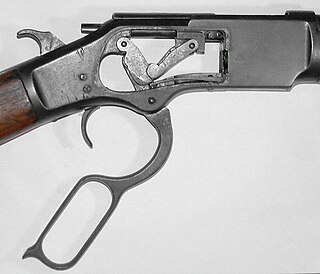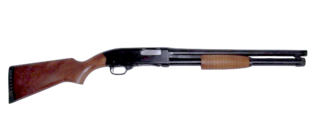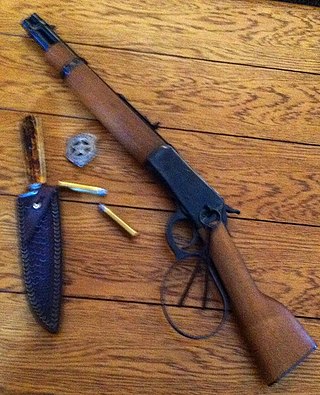
A shotgun is a long-barreled firearm designed to shoot a straight-walled cartridge known as a shotshell, which discharges numerous small spherical projectiles called shot, or a single solid projectile called a slug. Shotguns are most commonly used as smoothbore firearms, meaning that their gun barrels have no rifling on the inner wall, but rifled barrels for shooting sabot slugs are also available.

In firearm designs, the term single-shot refers to guns that can hold only a single round of ammunition inside and thus must be reloaded manually after every shot. Compared to multi-shot repeating firearms ("repeaters"), single-shot designs have no moving parts other than the trigger, hammer/firing pin or frizzen, and therefore do not need a sizable receiver behind the barrel to accommodate a moving action, making them far less complex and more robust than revolvers or magazine/belt-fed firearms, but also with much slower rates of fire.

John Moses Browning was an American firearm designer who developed many varieties of military and civilian firearms, cartridges, and gun mechanisms, many of which are still in use around the world. He made his first firearm at age 13 in his father's gun shop and was awarded the first of his 128 firearm patents on October 7, 1879, at the age of 24. He is regarded as one of the most successful firearms designers of the 19th and 20th centuries and a pioneer of modern repeating, semi-automatic, and automatic firearms.
Winchester rifle is a comprehensive term describing a series of lever action repeating rifles manufactured by the Winchester Repeating Arms Company. Developed from the 1860 Henry rifle, Winchester rifles were among the earliest repeaters. The Model 1873 was particularly successful, being marketed by the manufacturer as "The Gun That Won the West".
The Winchester Model 1897, also known as the Model 97, M97, Riot Gun, or Trench Gun, is a pump-action shotgun with an external hammer and tube magazine manufactured by the Winchester Repeating Arms Company. The Model 1897 was an evolution of the Winchester Model 1893 designed by John Browning. From 1897 until 1957, over one million of these shotguns were produced. The Model 1897 was offered in numerous barrel lengths and grades, chambered in 12 and 16 gauge, and as a solid frame or takedown. The 16-gauge guns had a standard barrel length of 28 in (71 cm), while 12-gauge guns were furnished with 30 in (76 cm) barrels. Special length barrels could be ordered in lengths as short as 20 in (51 cm) or as long as 36 in (91 cm). Since the time the Model 1897 was first manufactured, it has been used to great effect by American military personnel, law enforcement officers, and hunters.

A rim-fire is a type of metallic cartridge used in firearms where the primer is located within a hollow circumferential rim protruding from the base of its casing. When fired, the gun's firing pin will strike and crush the rim against the edge of the barrel breech, sparking the primer compound within the rim, and in turn ignite the propellant within the case. Invented in 1845 by Louis-Nicolas Flobert, the first rimfire metallic cartridge was the .22 BB Cap cartridge, which consisted of a percussion cap with a bullet attached to the top. While many other different cartridge priming methods have been tried since the early 19th century, such as teat-fire and pinfire, only small caliber rimfire cartridges have survived to the present day with regular use. The .22 Long Rifle rimfire cartridge, introduced in 1887, is by far the most common ammunition found in the world today in terms of units manufactured and sold.

A lever action is a type of action for repeating firearms that uses a manually operated cocking handle located around the trigger guard area that pivots forward to move the bolt via internal linkages, which will feed and extract cartridges into and out of the chamber, and cock the firing pin mechanism. This contrasts to other type of repeating actions such as the bolt-action, pump-action, semi-automatic, fully automatic, and/or burst mode actions. A firearm using this operating mechanism is colloquially referred to as a levergun.
Pump action is a type of manual firearm action that is operated by moving a sliding handguard on the gun's forestock. When shooting, the sliding forend is pulled rearward to eject any expended cartridge and typically to cock the hammer or striker, and then pushed forward to load a new cartridge into the chamber. Most pump-action firearms use an integral tubular magazine, although some do use detachable box magazines. Pump-action firearms are typically associated with shotguns, although it has been used in rifles, grenade launchers, as well as other types of firearms. A firearm using this operating mechanism is colloquially referred to as a pumpgun.
The Winchester Repeating Arms Company was a prominent American manufacturer of repeating firearms and ammunition. The firm was established in 1866 by Oliver Winchester and was located in New Haven, Connecticut. The firm went into receivership in 1931 and was bought by the Western Cartridge Company, a forerunner of the Olin Corporation. The Winchester brand name is still owned by the Olin Corporation, which makes ammunition under that name. The Winchester name is also used under license for firearms produced by two subsidiaries of the Herstal Group – FN Herstal of Belgium and the Browning Arms Company of Ogden, Utah.

Harrington & Richardson Arms Company is an American brand of firearms and a subsidiary of JJE Capital Holdings. H&R ceased independent production February 27, 2015.
The Winchester Model 1912, also commonly known as the Winchester 1912, Model 12, or M12, is an internal-hammer pump-action shotgun with an external tube magazine. Popularly named the Perfect Repeater at its introduction, it largely set the standard for pump-action shotguns over its 51-year high-rate production life. From August 1912 until first discontinued by Winchester in May 1964, nearly two million Model 12 shotguns were produced in various grades and barrel lengths. Initially chambered for 20 gauge only, the 12 and 16 gauge versions came out in 1913, and the 28 gauge version came out in 1934. A .410 version was never produced; instead, a scaled-down version of the Model 12 known as the Model 42, directly derived from scaled drawings of the Model 12, was produced in .410.
The Winchester Model 1894 rifle is a lever-action repeating rifle that became one of the most famous and popular hunting rifles of all time. It was designed by John Browning in 1894 and originally chambered to fire two metallic black powder cartridges, the .32-40 Winchester and .38-55 Winchester. It was the first rifle to chamber the smokeless powder round, the .30 WCF in 1895. In 1901, Winchester created the new .32 Winchester Special caliber with production of rifles starting in 1902.

Break action is a type of firearm action in which the barrel(s) are hinged much like a door and rotate perpendicularly to the bore axis to expose the breech and allow loading and unloading of cartridges. A separate operation may be required for the cocking of a hammer to fire the new round. There are many types of break-action firearms; break actions are universal in double-barreled shotguns, double-barreled rifles, combination guns, and are commonly found in single shot pistols, rifles, shotguns, including flare guns, grenade launchers, air guns, and some older revolver designs. They are also known as hinge-action, break-open, break-barrel, break-top, or, on old revolvers, top-break actions.

Stevens Arms is an American firearms manufacturer founded by Joshua Stevens in 1864 in Chicopee, Massachusetts. The company introduced the .22 Long Rifle round and made a number of rifle, shotgun, and target pistol designs. By 1902, they were advertising themselves as "the largest producers of sporting arms in the world". They were purchased by New England Westinghouse on May 28, 1915, and again by Savage Arms on April 1, 1920. As a division of Savage, Stevens continued to produce firearms at their Chicopee Falls facility until 1960 when the plant was torn down and Stevens production was moved into other Savage facilities. Savage dropped the Stevens name in 1991, but revived it in 1999 and still uses it today for a number of its low cost rifles and shotguns.

The Winchester Model 1892 was a lever-action repeating rifle designed by John Browning as a smaller, lighter version of his large-frame Model 1886, and which replaced the Model 1873 as the company's lever-action for pistol-caliber rounds such as the .44-40.

The Model 1200 is a pump-action shotgun that was manufactured by the Winchester-Western Division of Olin Corporation, starting 1964. It was redesignated the Model 1300 in 1978 with minimal changes. Production ceased in 2006 when the U.S. Repeating Arms Company, the subsequent manufacturer, went bankrupt. A militarized version of the Model 1200 was acquired by the U.S. Army for use during the Vietnam War. It is still in active service within various conflicts throughout the 21st century.

An antique firearm is a term used to describe a firearm that was designed and manufactured prior to the beginning of the 20th century. Although the exact definition of what constitutes an "antique firearm" varies between countries, the advent of smokeless powder or the start of the Boer War are often used as cut-off dates. Antique firearms are usually collected because of their historical interest and/or their monetary value.

The Mare's Leg is the name given to a customized shortened rifle used by Steve McQueen's character on the television series Wanted: Dead or Alive (1958–1961). McQueen's character was named Josh Randall. Mare's Leg is now a generic term for a Winchester Model 1892 with a shortened barrel and stock.
The Winchester Model 1886 was a lever-action repeating rifle designed by John Browning to handle some of the more powerful cartridges of the period. Originally chambered in .45-70 Government, .45-90 Sharps, and .40-82 Winchester, it was later offered in a half dozen other large cartridges, including the .50-110 Winchester. Despite being originally designed for use with black powder, the action was strong enough to make the jump to smokeless powder with only minor modifications, and was subsequently chambered in the smokeless .33 Winchester cartridge beginning in 1903.
Chiappa Firearms, Armi Sport di Chiappa, is an Italian firearms manufacturing company based in Brescia. It was founded in 1958 by Ezechiele Chiappa as Armi Sport. Total unit production is around 60,000 per year. Its U.S. headquarters are in Dayton, Ohio.













